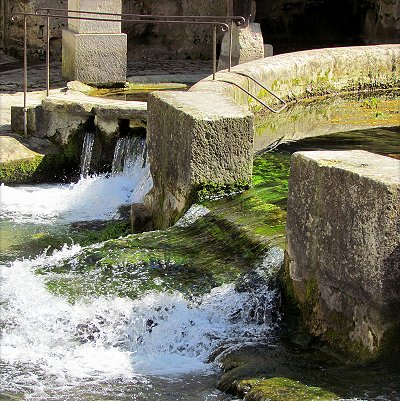
Like us on Facebook
PLACE NAMES


 
|
|
Tonnerre
|

|
|
Tonnerre is a commune in the Yonne department in Bourgogne-Franche-Comté in north-central France.
During the Roman era, Tonnerre was known as Tornodurum, which was derived from the Lingone word for "fortress". It was the capital of Pagus Tornodorensis. Here, in the valley of the Armançon, the County of Tonnerre was created, which served as a point of passage between Paris and Dijon, during a time when the King of France had designs on the Duchy of Burgundy.
Three etymologies of Tonnerre are rooted in the Celtic era: it is derived from Torn an obscure local deity; others claim it is from Douros, meaning fortress; yet others say it is connected to a place near the torrent. It is equally likely that the three solutions are one:
In 1782, newly discovered caves yielded weapons, ornaments, coins, and jewelry linked to the worship of deities.
The dominant fortress of Tonnerre was located upon the sites "Mont Bellant" and "Vieux Châteaux" which yield many ancient artifacts.
Amongst the overwhelming evidence of the area's religious heritage is the Fosse Dionne.
Historical sites and monuments include:
- Tonnerre Burgundy vineyard
- The Fosse Dionne, source of the high-flow-rate Vaucluse spring. A circular wash basin and Burgundy-tile-clad gallery was added in the 18th century. This tourist curiosity was dedicated to ancient deity from which the name "Divona", meaning "Divine" evolved into "Dionne".
- The Old Hospital or HÔtel-Dieu Notre-Dame des Fontenilles, founded in 1293 by Marguerite of Burgundy, it was built in just three years. It was of the first and largest hospitals in Medieval France. The building's dimensions are impressive: it has a 4,500-square-meter (50,000 sq ft) roof (originally covered in glazed tiles), main hall that is 90 meters (300 ft) long by 18.2 meters (60 ft) wide by 27 meters (89 ft) high. The ceiling is paneled and the enormous framework is in the form of a hull of an overturned ship. Up to 40 patients could be treated. The chapel contains the tomb of Marguerite of Burgundy, the mausoleum of François Michel Le Tellier de Louvois and a 15th-century shrine. There is also an 18th-century chaise longue and museum.
- Église Saint-Pierre, with its Baroque-style façade, dominates the city and offers a beautiful vista. Originally built in the 9th century, it has undergone many changes. It was nearly destroyed in a fire in 1556, which ravaged Tonnerre. Inside, one will find a pipe organ whose console dates to 1616, a pulpit that was built in 1712-1713 and stained-glass windows that date to the 16th century and restored in 2003. Nothing remains of the 11th century chapel.
- Église Notre-Dame de Tonnerre is a 12th-century gothic church. It was severely damaged by bombing during World War II.
- Hôtel d'Uzès, the childhood home of Charles de Beaumont, Chevalier d'Éon. It has been the property of the savings bank since 1879. Heavily restored in 1888, it is decorated with frescos by the painter Georges Henri Carré. There many other private mansions in Tonnerre.
- Ursuline Convent (until 1789) at Place Edmond-Jacob, currently a lycée (high school).
- Ursuline Convent (starting in 1805) on Rue Pasteur, is now attached to the lycée.
- Crypt of Saint Catherine, which contains Romanesque vaults, was built in the 12th century.
- Covered market, inaugurated in 1904, built in late 19th- and early 20th-century architectural style, in the iron-and-glass style of Victor Baltard.
- City hall, which overlooks the covered market.
- Château Vaulichères, former property of the House of Clermont-Tonnerre.
- The municipal museum and the library.
- The Promenade of the Pâtis.
 Feel free to Email me any additions or corrections Feel free to Email me any additions or corrections
LINKS AVAILABLE TO YOUR SITE
| | |





